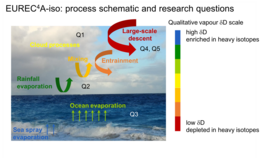Stable water isotopologues (here in short isotopes) such as H218O and 1H2H16O are probably best known for their use as climate proxies in paleoclimate reconstructions. However, in the past decade, they have gained in interest also for research on the present-day water cycle. What makes isotopes so attractive is that they are measurable tracers of moist diabatic processes in the atmosphere. The heavy versions of the water molecules preferably stay in the liquid phase due to their lower saturation vapour pressure than the lighter H216O species (the so-called “equilibrium effect”). In addition, due to their larger molecular weight, the heavy molecules have a smaller diffusion velocity through an unsaturated laminar layer (“non-equilibrium effect”). Thus the isotopic composition of a given water sample is determined by the integral of past phase changes that it has experienced.
The fascinating side of our beloved isotope perspective, is that it suddenly multiplies the available measurable constraints on the water cycle by the number of considered heavy molecules. The obfuscating side is that many processes affect the isotopic composition of meteoric waters from the microphysical cloud and below cloud processes, over turbulent and convective mixing to transport by large-scale flow features (Fig. 1). We thus have to cope with processes and environmental controlling variables at many different scales, when trying to use isotopes to nail down moisture fluxes from one given process. Thus EUREC4A is for us a great opportunity to improve our understanding of the variability of isotope signals at the timescale of a few minutes to hours. In particular, thanks to the wealth of complementary observations planned by many of you during this campaign, we will have an unprecedented chance for quantifying the sensitivity of these isotope signals to the processes affecting their abundance.
The rationale behind using isotopes for contributing to our understanding of low-level cloudiness over the tropical North Atlantic is the strong contrasts in the isotope signature of the very dry descending free tropospheric airmass (very low amount of heavy molecules), the freshly evaporated ocean water (large amount of heavy molecules), and the below cloud rainfall evaporate (intermediate amount of heavy molecules, see also the simplified process schematic in Fig. 1). These sources of atmospheric moisture can then be mixed in many different ways by turbulent eddies, by convective up- and downdrafts, which leads to important short-term variability in our isotope timelines (e.g. Fig.2).
As you may guess, the isotope perspective of EUREC4A is multifaceted and interdisciplinary, involving isotope climatologists, dynamicists and oceanographers. We currently plan to perform multiplatform in-situ measurements with laser spectrometers (BCO, ships, ATR aircraft) and sampling of precipitation, to include remote sensing retrievals (IASI, AIRS) and to use models at different scales and of different complexity (simple analytical models, trajectory-based box models, IsoSAM, ICONiso, COSMOiso, LMDZiso, iCAM).
In essence our science is driven by the following four categories of questions that we would like to address within EUREC4A-iso :
1) Isotopes and trade wind cumulus organisation: Do water isotope signals reflect different types of organisation of low-level trade wind clouds? If yes how?
2) Boundary layer moisture budget: Can we obtain a detailed characterisation of the sub-cloud layer isotope budget using the EUREC4A multiplatform observations combined with isotope-enabled LES simulations?
3) Coupling to the ocean surface and turbulent fluxes: How does the ocean surface couple to mixing in the boundary layer and the shallow cumulus clouds structure?
4) Large-scale circulation coupling: What is the role of large-scale advection terms in the isotope budgets of the free troposphere and the sub-cloud layer?
5) Coupling between the tropical and the extratropical water cycles: What is the role of extratropical dry intrusions and how does the isotope signature of moisture evaporated in the tropics translate into extratropical signals during tropical moisture exports?
We are looking forward to inspiring coming months of campaign planning and of course to the true EUREC4A campaign in 2020!
Best wishes
The EUREC4A-iso Team
Franziska Aemisegger and Heini Wernli - Atmospheric Dynamics, ETH Zürich
Peter Blossey and Marina Dütsch – Seattle, University of Washington
Cyrille Flamant – LATMOS, Université Paris-Saclay
Joe Galewsky – Albuquerque, University of New Mexico
David Noone - Corvallis, Oregon State University
Gilles Reverdin - LOCEAN, Université Pierre et Marie Curie, Paris
Camille Risi – LMD, Université Pierre et Marie Curie, Paris
Harald Sodemann - GFI, Universitetet i Bergen
Stephan Pfahl - Freie Universität Berlin


